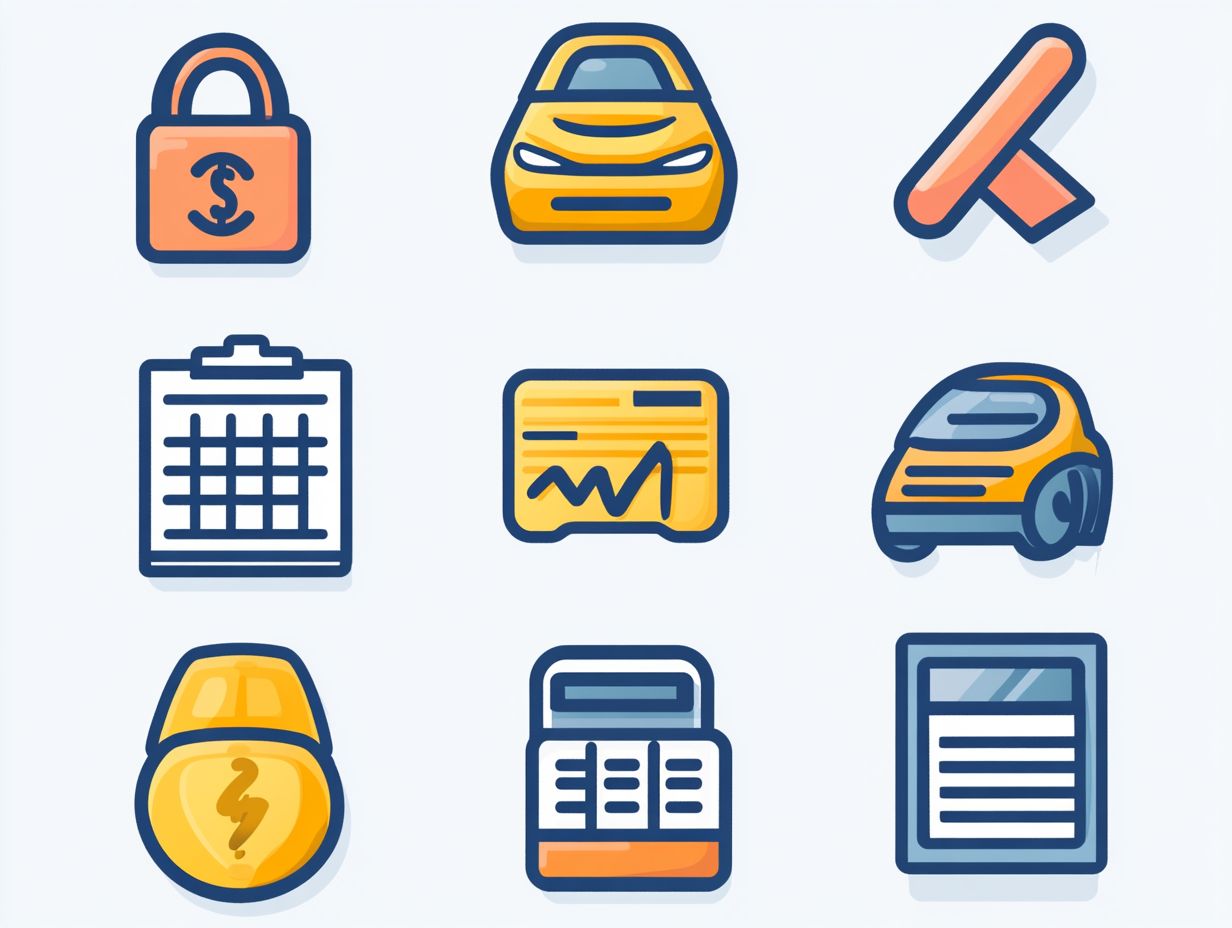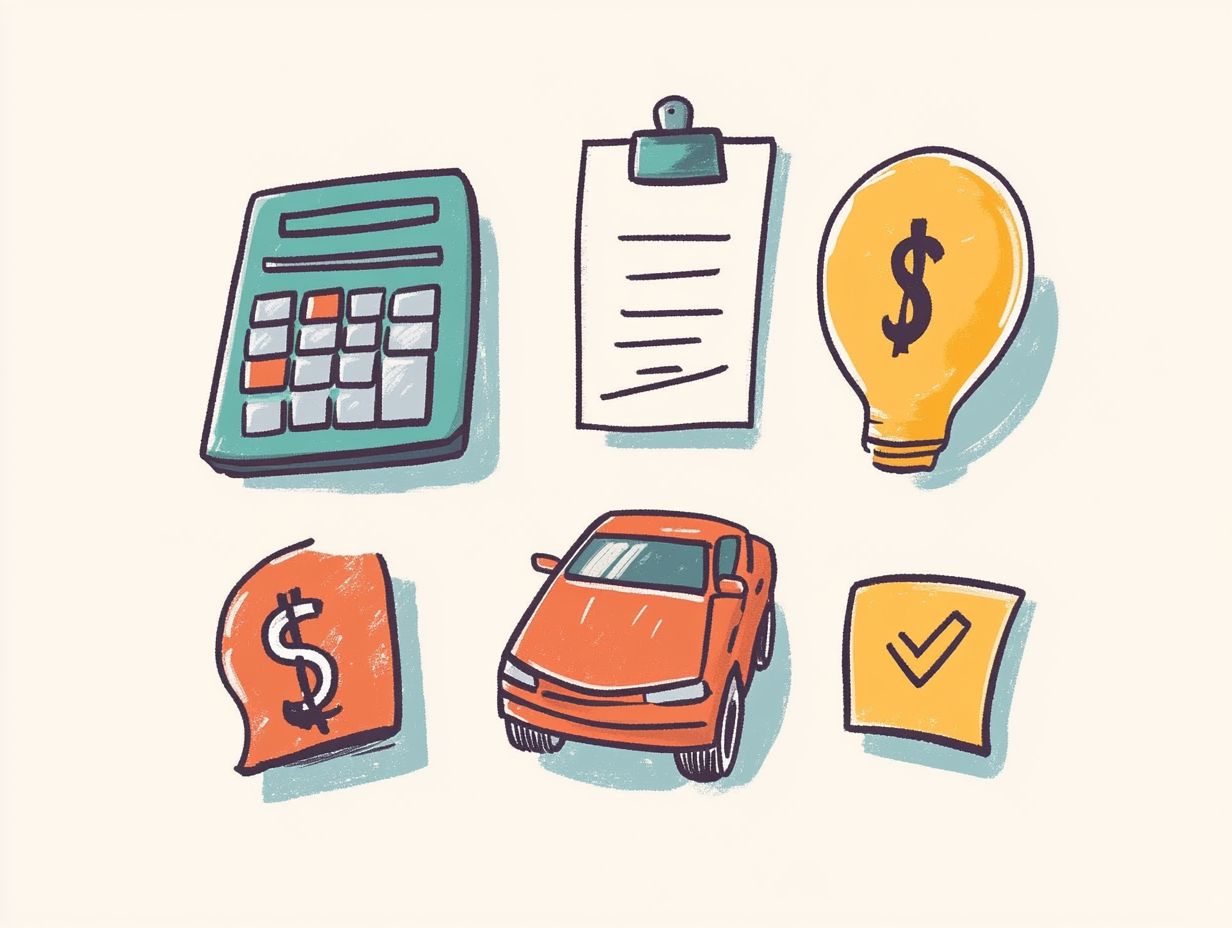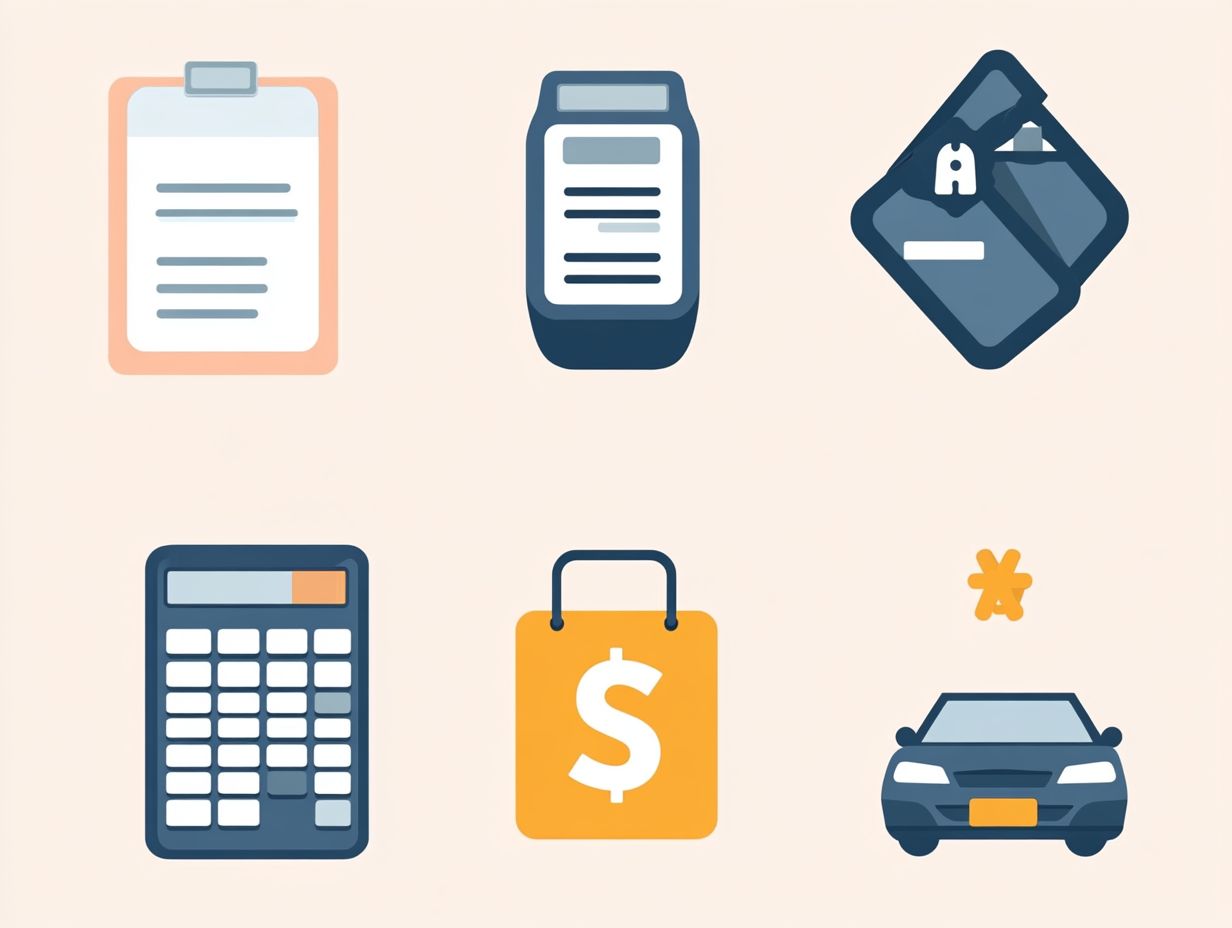10 Tips to Lower Your Auto Insurance Premiums
Navigating the realm of auto insurance can feel utterly overwhelming, particularly when it comes to managing expenses. Whether you re a seasoned driver or a fresh-faced car owner, uncovering ways to lower your premiums is crucial. Ready to start saving? Let’s dive into these tips!
This article offers practical tips designed to help you save money without compromising coverage. From exploring different rates to understanding available discounts, you ll discover strategies that keep your insurance costs manageable.
Dive in and start your journey to savings today!
Contents
- Key Takeaways:
- 1. Shop Around for the Best Rates
- 2. Maintain a Good Credit Score
- 3. Consider Bundling Your Policies
- 4. Opt for a Higher Deductible
- 5. Drive Safely and Avoid Accidents
- 6. Take Advantage of Discounts
- 7. Choose a Vehicle with Low Insurance Rates
- 8. Keep Your Car Safe and Secure
- 9. Review Your Policy Regularly
- 10. Consider Usage-Based Insurance
- What Factors Affect Auto Insurance Premiums?
- What Are the Different Types of Coverage Available?
- How Can a Driver with a Poor Driving Record Lower Their Premiums?
- What Are the Most Common Mistakes People Make When Trying to Lower Their Premiums?
- How Can a Person Lower Their Premiums If They Have Multiple Vehicles?
- What Are Some Ways to Lower Premiums for Teenage Drivers?
- Frequently Asked Questions
- Can I lower my auto insurance premiums?
- What is the best way to lower my auto insurance premiums?
- Do my driving habits affect my auto insurance premiums?
- Can I save money on my premiums by bundling my insurance policies?
- How can maintaining good credit help lower my auto insurance premiums?
- Are there any discounts available to help lower my auto insurance premiums?
Key Takeaways:

To get the best insurance rates, shop around. A good credit score helps too! Bundling your policies can lead to great discounts.
1. Shop Around for the Best Rates
Shopping around for the best car insurance rates is crucial to secure competitive pricing and optimal coverage tailored to your specific needs. Different insurance companies often provide varying quotes based on factors such as your driving record, credit score, and the vehicle you own.
By comparing multiple quotes from major insurers, you can uncover significant differences in premiums, policy features, and coverage limits. Utilizing online tools and consumer reports can greatly streamline this process, giving you the power to make informed decisions.
These resources outline the pros and cons of various plans and highlight potential discounts available for:
- Safe driving
- Bundling policies
- Maintaining a good credit score
Taking the time to shop around can lead to significant savings. Start comparing quotes now, and watch your savings grow!
2. Maintain a Good Credit Score
A good credit score greatly influences your car insurance costs, as many insurance companies rely on this metric to assess how likely you are to pay your bills on time. This assessment directly impacts the premium prices you pay and the discounts you may qualify for.
When insurers evaluate your credit score, they often link it to the likelihood of you filing a claim. Those with higher scores are seen as less of a risk, making them eligible for more favorable rates. By maintaining a solid credit score, you not only save money on your car insurance but also enhance your overall financial health.
To boost your credit score, consider these effective strategies:
- Pay your bills on time.
- Reduce your debt levels.
- Regularly check your credit reports for inaccuracies.
Utilizing various online platforms or apps to monitor your credit score can provide valuable insights. Stay informed and take corrective actions whenever necessary!
3. Consider Bundling Your Policies
Bundling your car insurance with other policies, such as homeowners insurance, can significantly bolster your financial stability. This approach often unlocks substantial discounts, effectively lowering your overall insurance costs.
This strategy not only reduces individual premiums but also streamlines your policy management, making it easier to keep track of renewals and payments. For example, leading insurance companies like State Farm and Allstate frequently offer enticing discounts when you combine auto and home coverage.
You can even extend this bundling to other types of policies, such as renters, life, or umbrella insurance, allowing you to maximize your savings. By consolidating all your policies with a single provider, you ll likely enjoy enhanced customer service and a clearer understanding of your overall coverage needs.
It’s a savvy move that pays off in both convenience and cost. Start bundling today to see the benefits!
4. Opt for a Higher Deductible
Choosing a higher deductible for your car insurance can lead to lower premiums. Insurers reward policyholders willing to take on more responsibility after an accident by lowering their insurance costs, but it’s also important to know 5 tips for retaining your premium discounts.
This strategy balances immediate savings and long-term expenses. It’s great for those who rarely file claims or drive older vehicles. If you fit this profile, you might prefer saving on premiums rather than risking higher out-of-pocket costs.
Think carefully about your finances. Unexpected repairs can lead to hefty payouts if your deductible is set too high.
Knowing how your deductible affects your coverage can save you money. Evaluate your unique circumstances before making a decision.
Start evaluating your options today!
5. Drive Safely and Avoid Accidents
Driving safely boosts road safety and helps you build a good driving record. This can lead to lower car insurance premiums and discounts, such as those for completing a safe driving course.
By maintaining a claims-free history, you protect your finances while showing insurers you are a responsible, low-risk driver. Insurance companies reward drivers with clean records by offering significantly lower rates.
Implement effective accident prevention strategies like following speed limits, avoiding distractions, and keeping your vehicle well-maintained. For retirees, these habits can lead to savings, as highlighted in 5 tips for retirees to save on auto insurance. Insurance companies value safe driving habits and often use them in premium calculations.
Start evaluating your options today!
6. Take Advantage of Discounts

Taking advantage of discounts for insurance can lead to big savings on your car insurance premiums. Consider exploring 5 ways to reduce premiums for young drivers, such as mileage discounts or rewards for completing safe driving courses.
These discounts reward you for driving safely and making smart choices. If you maintain a clean driving record, you re likely to benefit as a good driver.
If you’re a member of organizations like AARP, you may access discounts for older adults. Keep a clean driving history and consider enrolling in defensive driving courses.
Start evaluating your options today!
7. Choose a Vehicle with Low Insurance Rates
Pick a vehicle with excellent safety features and low insurance rates to lower your overall costs. To further reduce your premiums, consider implementing 5 seasonal tips to lower your auto insurance, as insurers consider vehicle safety ratings when calculating your costs.
Ratings from trusted sources, like the Insurance Institute for Highway Safety, show how well a vehicle performs in crashes. Features like anti-lock brakes and airbags enhance safety and often lead to lower rates.
Spend some time researching possible cars on platforms like Kelley s Blue Book. This gives you the power to make informed choices that fit your budget and safety needs.
Start evaluating your options today!
8. Keep Your Car Safe and Secure
Keeping your car safe and secure through measures like installing anti-theft devices and parking in secure locations can significantly enhance your financial health. By doing so, you may reduce your premium payments and improve your claims-free history.
The advantages of vehicle security features extend beyond just peace of mind. They can impact your insurance coverage limits and premiums significantly.
For example, many insurers offer discounts for vehicles equipped with advanced safety technologies, such as automatic emergency braking or vehicle tracking systems.
To maximize your potential savings, invest in strong car security measures. Stay informed about your insurance policies by reviewing coverage options regularly.
Ultimately, committing to both preventative measures and informed insurance choices can create a more secure driving experience and provide you with financial relief.
9. Review Your Policy Regularly
Review your insurance policy regularly to avoid surprises! Regularly reviewing your insurance policy keeps you in the loop about any changes in coverage, potential premium increases, and newly available discounts or benefits. This awareness gives you the power to make adjustments when necessary.
Staying up-to-date with your insurance rates is vital for safeguarding yourself against overpaying or encountering unexpected out-of-pocket expenses. It s wise to reassess your policies at least once a year or whenever significant life changes occur, like moving, getting married, or acquiring valuable assets.
When discussing your needs with insurance agents, clarity is key. Be specific about your requirements and any changes in your situation to ensure they can provide tailored advice. Open communication can lead to discovering better deals or coverage options that align with your evolving circumstances.
10. Consider Usage-Based Insurance
Considering usage-based insurance can be a savvy move for drivers whose habits reflect safer driving patterns. Imagine saving money just by being a safe driver! With usage-based insurance, you can do just that. This flexible option allows you to lower your premiums based on your actual driving behavior, rather than relying on traditional metrics.
By utilizing advanced monitoring devices or mobile apps that track key aspects of your driving like speed, braking habits, and time spent on the road you can gain valuable insights into your driving style. This data is analyzed to adjust your premiums, providing an incentive for safe driving practices.
While the allure of reduced costs is hard to resist, it s crucial to recognize that not all drivers may reap the same benefits. You might have significant concerns about privacy and the accuracy of the collected data. Some may also find it difficult to adjust their driving habits to meet the expectations set by this type of insurance.
What Factors Affect Auto Insurance Premiums?
Several factors play a significant role in determining your auto insurance premiums, including your driving record, credit score, vehicle features, and overall insurance costs. Together, these elements help insurers evaluate the risk associated with insuring you.
For instance, maintaining a clean driving record often translates to lower premiums, as it suggests a reduced likelihood of accidents. Conversely, a poor credit score may indicate a higher risk, leading insurers to increase your rates. The features of your vehicle are equally important; cars equipped with modern safety features may even qualify for discounts.
Your driving habits also directly impact your costs, creating a dynamically relationship between your behavior and your premiums.
By understanding these interconnections, you can make informed choices that help mitigate your insurance expenses.
What Are the Different Types of Coverage Available?

Understanding the various types of coverage available in an insurance policy is essential for selecting the auto coverage that aligns perfectly with your unique needs. This includes collision insurance, comprehensive coverage, and liability coverage. Each type serves a specific purpose and addresses distinct scenarios you may encounter as a driver. For instance, collision insurance proves invaluable if you find yourself in an accident, regardless of fault, as it covers the repair costs for your vehicle. Comprehensive coverage protects you against non-collision-related incidents, such as theft or natural disasters, offering you valuable peace of mind.
Liability coverage, which is required by law in most areas, shields you from financial loss resulting from damages you may cause to others. Grasping how these coverages interact and knowing their limits can significantly enhance your financial security in the event of an accident or loss.
How Can a Driver with a Poor Driving Record Lower Their Premiums?
A driver with a not-so-great driving record can take proactive measures to lower their premiums by focusing on building an accident-free record, enrolling in a safe driving course, and effectively applying savings tips. By committing to these strategies, you enhance your driving skills and signal to insurers that you are a responsible road user. Many insurance companies offer discounts for completing defensive driving courses, which can lead to significant reductions in your premiums over time.
Maintaining a clean record is essential; every year without accidents or violations can pave the way for improved rates. It’s also wise to regularly review and compare insurance policies, as some may offer better incentives for safe driving habits. Consistent effort in these areas can translate into tangible financial benefits.
What Are the Most Common Mistakes People Make When Trying to Lower Their Premiums?
Many people face common mistakes while attempting to lower their insurance premiums, such as neglecting to shop around for available discounts or failing to inquire with their agents about potential savings programs. This can result in inflated premium costs. Additionally, some may overlook the essential tips for finding affordable auto insurance, which causes them to miss updated coverage options or more favorable rates that have emerged since their last assessment.
Don’t miss out on the chance to save! Thorough research can uncover various offerings tailored to your unique situation, enabling you to compare what different providers have to offer. Investing time to understand available discounts, such as bundling policies or maintaining a clean driving record, can lead to significant cost reductions. Engaging in open conversations with your agents highlights potential savings and ensures you have a comprehensive grasp of your options.
How Can a Person Lower Their Premiums If They Have Multiple Vehicles?
If you own multiple vehicles, you can easily lower your premiums by exploring options like bundling your insurance policies. This often leads to significant premium deductions and a reduction in your overall insurance costs. By consolidating your policies under a single insurer, you can realize considerable savings. This approach streamlines your management process and fosters a stronger relationship with your provider.
To secure the best bundling deals, begin by researching various insurers and their offerings. It s wise to request quotes from multiple companies for a thorough comparison of rates and terms. Don t shy away from negotiating directly with insurers; you might uncover special discounts or incentives that aren t immediately advertised. Sharing details about your safe driving record and any additional coverage needs can further improve your chances of landing a favorable bundling option.
Start comparing quotes today to maximize your savings!
What Are Some Ways to Lower Premiums for Teenage Drivers?
Lowering premiums for teenage drivers may seem daunting, but it s entirely achievable with a few strategic moves. Consider enrolling them in a safe driving course or maintaining a clean claims history. Don t forget to take advantage of any available discounts that might apply to their insurance.
It’s important to talk openly about safe driving practices. Involving teens in discussions about insurance costs and coverage options helps them grasp how their driving behavior influences premium rates. Encourage them to adopt safe driving techniques and set personal milestones, like going a set period without accidents.
This approach helps build safe driving habits and gives them the power, demonstrating that their choices significantly impact their financial responsibilities.
Frequently Asked Questions

Yes, there are several ways to lower your auto insurance premiums. Start saving today with 5 easy ways to lower your auto insurance rates!
The best way to lower your auto insurance premiums is to shop around and compare quotes from different insurance companies. By exploring smart ways to lower your auto insurance costs, you may be able to find a better deal and save money on your premiums.
Yes, your driving habits can affect your auto insurance premiums. If you have a history of accidents or traffic violations, you may be considered a higher risk and have higher premiums. Safe driving can help lower your premiums.
Yes, many insurance companies offer discounts for bundling your auto insurance with other policies, such as homeowners or renters insurance. This can help lower your overall premiums.
Insurance companies often use credit scores to determine premiums, so maintaining good credit can help lower your auto insurance premiums. For students, following 5 tips to save on auto insurance can also be beneficial. Make sure to pay bills on time and keep your credit utilization low.
Yes, there are several discounts available that can help lower your auto insurance premiums. These may include discounts for safe driving, being a student, or having certain safety features on your car.
Check with your insurance provider today!

